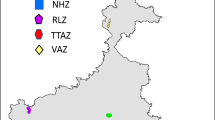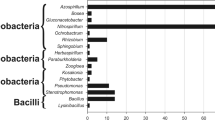Abstract
Main conclusion
The diversity of endophytic and epiphytic diazotrophs in different parts of rice plants has specificity to the niche (i.e. leaf, stem and root) of different genotypes and nutrient availability of the organ.
Inoculation of the indigenous, polyvalent diazotrophs can facilitate and sustain production of non-leguminous crops like rice. Therefore, N2-fixing plant growth promoting bacteria (PGPB) were isolated from different parts of three Indian cultivated [Oryza sativa L. var. Sabita (semi deep/deep water)/Swarna (rain fed shallow lowland)/Swarna-Sub1(submergence tolerant)] and a wild (O. eichingeri) rice genotypes which respond differentially to nitrogenous fertilizers. Thirty-five isolates from four rice genotypes were categorized based on acetylene reduction assay on nitrogenase activity, biochemical tests, BIOLOG and 16S rRNA gene sequencing. The bacteria produced 9.36–155.83 nmole C2H4 mg−1 dry bacteria h−1 and among them nitrogenase activity of 11 potent isolates was complemented by nifH–sequence analysis. Phylogenetic analysis based on 16S rDNA sequencing divided them into five groups (shared 95–100 % sequence homology with type strains) belonging to five classes—alpha (Ancylobacter, Azorhizobium, Azospirillum, Rhizobium, Bradyrhizobium, Sinorhizobium, Novosphingobium, spp.), beta (Burkholderia sp.), gamma (Acinetobacter, Aeromonas, Azotobacter, Enterobacter, Klebsiella, Pantoea, Pseudomonas, Stenotrophomonas spp.) Proteobacteria, Bacilli (Bacillus, Paenibacillus spp.) and Actinobacteria (Microbacterium sp.). Besides, all bacterial strains possessed the intrinsic PGP traits of like indole (0.44–7.4 µg ml−1), ammonia (0.18–6 mmol ml−1), nitrite (0.01–3.4 mol ml−1), and siderophore (from 0.16–0.57 μmol ml−1) production. Inoculation of rice (cv. Swarna) seedlings with selected isolates had a positive impact on plant growth parameters like shoot and root elongation which was correlated with in vitro PGP attributes. The results indicated that the diverse polyvalent phytonic PGP bacteria, which may be exploited as bio-inoculants to improve rice production.




Similar content being viewed by others
References
Ahmad F, Ahmad I, Khan MS (2005) Indole acetic acid production by the indigenous isolates of Azotobacter and fluorescent Pseudomonas in the presence and absence of tryptophan. Turk J Biol 29:29–34
Arshad M, Frankenberger WT (1998) Plant growth-regulating substances in the rhizosphere: microbial production and functions. Adv Agronom 62:46–152
Bakker PAHM, Pierterse CMJ, Van Loon LC (2007) Induced systemic resistance by fluorescent Pseudomonas spp. Phytopathology 9:239–243
Banik A, Mukhopadhyay SK, Sahana A, Das D, Dangar TK (2015) Fluorescence resonance energy transfer (FRET) based technique for tracking of endophytic bacteria in rice roots. Biol Fertil Soils. doi:10.1007/s00374-015-1064-6
Bashan Y, de-Bashan LE, Prabhu SR, Hernandez JP (2014) Advances in plant growth-promoting bacterial inoculant technology: formulations and practical perspectives (1998–2013). Plant Soil 378:1–33
Berg G (2009) Plant–microbe interactions promoting plant growth and health: perspectives for controlled use of microorganisms in agriculture. Appl Microbiol Biotechnol 84:11–18
Boone DR, Castenholz RW, Garrity GM, Brenner DJ, Krieg NR, Staley JT (2005) Bergey’s manual® of systematic bacteriology, vol 2. Springer Science and Business Media, Berlin
Bric JM, Bostock RM, Silverstone SE (1991) Rapid in situ assay for indoleacetic acid production by bacteria immobilized on a nitrocellulose membrane. Appl Environ Microbiol 57:535–538
Canfield DE, Glazer A, Falkowski PG (2010) The evolution and future of Earth’s nitrogen cycle. Science 330:192–196
Cappuccino JG, Sherman N (1992) Biochemical activities of microorganisms. Microbiology, a laboratory manual. The Benjamin/Cummings Publishing Co, California
Castillo JM, Casas J, Romero E (2011) Isolation of an endosulfan-degrading bacterium from a coffee farm soil: persistence and inhibitory effect on its biological functions. Sci Total Environ 412:20–27
Charlot G (1965) Colorimetric determination of elements. Principles and methods. Elsevier Publishing Co., New York
Dimkpa C, Svatos A, Merten D, Buchel G, Kothe E (2008) Hydroxamate siderophoresproduced by Streptomyces acidiscabies E13 bind nickel and promote growth in cowpea (Vigna unguiculata L.) under nickel stress. Can J Microbiol 5:163–172
Gaby JC, Buckley DH (2012) A comprehensive evaluation of PCR primers to amplify the nifH gene of nitrogenase. PLoS One 7:e42149
Garland JL, Mills AL (1991) Classification and characterization of heterotrophic microbial communities on the basis of patterns of community-level sole-carbon-source utilization. Appl Environ Microbiol 57:2351–2359
Gillis M, Vandamme P, De Vos P, Swings J, Kersters K (2001) Polyphasic taxonomy. Bergey’s manual of systematic bacteriology, vol 1. Springer, New York, p 4348
Hallmann J, Berg G (2006) Spectrum and population dynamics of bacterial root endophytes. In: Schulz B, Boyle C, Sieber T (eds) Microbial root endophytes. Springer, Berlin, pp 15–31
Hardy R, Burns RC, Holsten RD (1973) Applications of the acetylene–ethylene assay for measurement of nitrogen fixation. Soil Biol Biochem 5:47–81
Islam MR, Madhaiyan M, Deka BH, Yim W, Saravanan VS, Fu Q, Hu H, Sa T (2009) Characterization of plant growth-promoting traits of free-living diazotrophic bacteria and their inoculation effects on growth and nitrogen uptake of crop plants. J Microbiol Biotechnol 19:1213–1222
Jensen HL (1951) Notes on the biology of Azotobacter. In: Proceedings of the Society for Applied Bacteriology 14, No. 1; Blackwell Publishing Ltd
Ji SH, Gururani MA, Chun SC (2014) Isolation and characterization of plant growth promoting endophytic diazotrophic bacteria from Korean rice cultivars. Microbiol Res 169:83–98
Johnston-Monje D, Raizada MN (2011) Integration of biotechnologies plant and endophyte relationships: nutrient management. In: Murray Moo-Young (ed) Comprehensive biotechnology, 2nd edn, vol 4. Elsevier, pp 713–727. doi:10.1016/B978-0-08-088504-9.00264-6
Kang SH, Cho H-S, Cheong H, Ryu C-M, Kim JF, Park S (2007) Two bacterial endophytes eliciting boot plant growth promotion and plant defence on pepper (Capsicum annuum L.). J Microbiol Biotechnol 17:96–103
Kubo M, Purevdorj M (2004) The future of rice production and consumption. J Food Distrib Res 35:128–142
Leigh JA, Signer ER, Walker GC (1985) Exopolysaccharide-deficient mutants of Rhizobium meliloti that form ineffective nodules. Proc Natl Acad Sci USA 82:6231–6235
Leveau JH, Lindow SE (2005) Utilization of the plant hormone indole-3-acetic acid for growth by Pseudomonas putida strain 1290. Appl Environ Microbiol 71:2365–2371
Mano H, Morisaki H (2007) Endophytic bacteria in the rice plant. Microbes Environ 23:109–117
Mignard S, Flandrois J (2006) 16S rRNA sequencing in routine bacterial identification: a 30-month experiment. J Microbiol Methods 67:574–581
Monon J (2012) The growth of bacterial cultures. Selected Papers in Molecular Biology by Jacques Monod: 139
Naik BS, Shashikala J, Krishnamurthy YL (2009) Study on the diversity of endophytic communities from rice (Oryza sativa L.) and their antagonistic activities in vitro. Microbiol Res 164:290–296
Nakos GG, Wolcott AR (1972) Bacteriostatic effect of ammonium on Nitrobacter agilis in mixed culture with Nitrosomonas europaea. Plant Soil 36:521–527
Oka N, Hartel PG, Finlay-Moore O, Gagliardi J, Uberer DA, Fuhrmann JJ, Angle JS, Skipper HD (2000) Misidentification of soil bacteria by fatty acid methyl ester (FAME) and BIOLOG analyses. Biol Fertil Soils 32:256–258
Okon Y, Albrecht SL, Burris RH (1977) Methods for growing Spirillum lipoferum and for counting it in pure culture and in association with plants. Appl Environ Microbiol 33:85–88
Panda D, Sarkar RK (2013) Structural carbohydrates and lignifications associated with submergence tolerance in rice (Oryza sativa L.). J Stress Physiol Biochem 9:299–306
Poly F, Monrozier LJ, Bally R (2001) Improvement in the RFLP procedure for studying the diversity of nifH genes in communities of nitrogen fixers in soil. Res Microbiol 152:95–103
Ravikumar S, Kathiresan K, Ignatiammal STM, Selvam MB, Shanthy S (2004) Nitrogen-fixing Azotobacters from mangrove habitat and their utility as marine biofertilizers. J Exp Mar Biol Ecol 312:5–17
Reddy BP, Reddy KRN, Subba RM, Rao KS (2008) Efficacy of antimicrobial metabolites of Pseudomonas fluorescens against rice fungal pathogens. Curr Trend Biotechnol Pharm 2:178–182
Rohlf FJ (2000) NTSYS-pc: Numerical Taxonomy System.; Ver.2.1. Exeter Publishing Ltd., Setauket
Ryan RP, Germaine K, Franks A, Ryan DJ, Dowling DN (2008) Bacterial endophytes: recent developments and applications. FEMS Microbiol Lett 278:1–9
Sahoo RK, Ansari MW, Dangar TK, Mohanty S, Tuteja N (2014) Phenotypic and molecular characterisation of efficient nitrogen-fixing Azotobacter strains from rice fields for crop improvement. Protoplasma 251:511–523
Sarathambal C, Ilamurugu K, Balachandar D, Chinnadurai C, Gharde Y (2015) Characterization and crop production efficiency of diazotrophic isolates from the rhizosphere of semi-arid tropical grasses of India. Appl Soil Ecol 87:1–10
Sun LN, Zhang YF, He LY, Chen ZJ, Wang QY, Qian M, Sheng XF (2010) Genetic diversity and characterization of heavy metal-resistant-endophytic bacteria from two copper-tolerant plant species on copper mine wasteland. Bioresour Technol 101:501–509
Tamura K, Stecher G, Peterson D, Filipski A, Kumar S (2013) MEGA6: molecular evolutionary genetics analysis version 6.0. Mol Biol Evol 30:2725–2729
Tan RX, Zou WX (2001) Endophytes: a rich source of functional metabolites. Nat Prod Rep 18:448–459
Verma SC, Ladha JK, Tripathi AK (2001) Evaluation of plant growth promoting and colonization ability of endophytic diazotrophs from deep water rice. J Biotechnol 91:127–141
Wang W, Qiu Z, Tan H, Cao L (2014) Siderophore production by actinobacteria. Biol Metals 27:623–631
Wei CY, Lin L, Luo LJ, Xing YX, Hu CJ, Yang LT, Li YR, An Q (2014) Endophytic nitrogen-fixing Klebsiella variicola strain DX120E promotes sugarcane growth. Biol Fertil Soils 50:657–666
Weisburg WG, Barns SM, Pelletier DA, Lane DJ (1991) 16S ribosomal DNA amplification for phylogenetic study. J Bacteriol 173:697–703
Wragg P, Randall L, Whatmore A (2014) Comparison of Biolog GEN III MicroStation semi-automated bacterial identification system with matrix-assisted laser desorption ionization-time of flight mass spectrometry and 16S ribosomal RNA gene sequencing for the identification of bacteria of veterinary interest. J Microbiol Methods 105:16–21
Zeigler RS, Barclay A (2008) The relevance of rice. Rice 1:3–10
Acknowledgments
This work has been financially support by Indian Council of Agricultural Research (ICAR) project “AMAAS” (application of microorganisms in agriculture and allied sector).
Author information
Authors and Affiliations
Corresponding author
Ethics declarations
Conflict of interest
The authors declare that they have no conflict of interest.
Electronic supplementary material
Below is the link to the electronic supplementary material.
Rights and permissions
About this article
Cite this article
Banik, A., Mukhopadhaya, S.K. & Dangar, T.K. Characterization of N2-fixing plant growth promoting endophytic and epiphytic bacterial community of Indian cultivated and wild rice (Oryza spp.) genotypes. Planta 243, 799–812 (2016). https://doi.org/10.1007/s00425-015-2444-8
Received:
Accepted:
Published:
Issue Date:
DOI: https://doi.org/10.1007/s00425-015-2444-8




